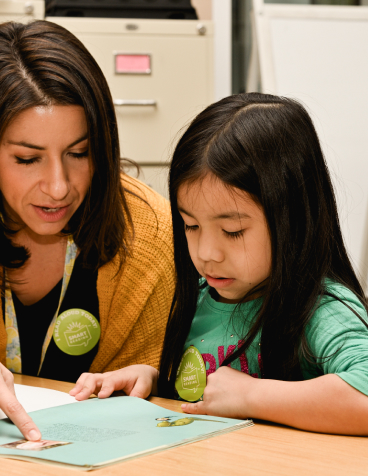SMART
Theory of Change
SMART Reading empowers students across Oregon to read and succeed. With research as the foundation, SMART’s Theory of Change describes how two proven strategies lead to literacy success.




Access to Books
Each addition to a home library helps children get a little further in school. SMART students choose two books per month to keep, helping them build their personal libraries and become lifelong readers.
Children with access to 25 books at home will, on average, complete two more years of school than children from homes without any books at all.
Stat Sources: Jim Lindsay. Children’s Access to Print Materials and Education-Related Outcomes: Findings from a Meta-Analytic Review. Learning Point Associates & reading is Fundamental, 2010.

Reading Time
SMART students participate in one-on-one, high-interest, child-guided reading experiences with a trained volunteer.
Kids 4-5 years old gain six months of reading ability simply by being read to three to five times per week.
Stat Source: Proof of benefits of reading to children, The Sydney Morning Herald, March 2013.
Cultural Affirmation
SMART emphasizes providing books that mirror students’ identities and provide windows into other people, backgrounds and cultures.
This is particularly important for children of color, because only 13% of children’s books are written by or about people of color, yet reading materials that reflect children’s sociocultural experiences are proven to increase reading comprehension and language skills.
Stat Sources: 1. Publishing Statistics on Children’s Books about People of Color and First/Native Nations and by People of Color and First/Native Nations Authors and Illustrators. Cooperative Children’s Book Center, School of Education, University of Wisconsin-Madison. (2015) 2. Hughes-Hassell, S., Barkley, J.A., & Koehler, E. (2009). Promoting equity in children’s literacy instruction: using a critical race theory framework to examine transitional books. School Library Medical Research, 12. 3. The Diversity Gap in Children’s Publishing.

Enjoyment
The logic is simple: when kids think reading is fun, they want to do it! SMART students choose the books that are interesting to them.
When asked which book they enjoyed most, 80% of students said that the most interesting book they had read that week was one they chose themselves.
Stat Source: Gambrell, L.B. (1996). Creating classroom cultures that foster reading motivation. The Reading Teacher, 50.
Motivation
Reading motivation is linked with more time spent reading, increased reading comprehension, and self-confidence.
75%of SMART students improved toward reading motivation benchmarks after participating in the SMART program.
Stat Source: SMART Student Milestones, 2016

Positive Outcomes
Increased Literacy Success
Together, shared reading time, access to books, and reading motivation and enjoyment form a critical foundation for literacy development.
Reach the 3rd Grade Benchmark
A student who can’t read at grade level by third grade is four times less likely to graduate than a child who reads proficiently. In Oregon in the 2021-22 school year, over half of third-grade students didn’t meet this critical benchmark. (1)
Racial, Social & Economic Parity
All children have the potential to become successful readers and lifelong learners. SMART engages the community to support students as they develop a love for reading and build a strong foundation for future academic success.
1. Source: Double Jeopardy: How Third-Grade Reading Skills and Poverty Influence High School Graduation. Annie E. Casey Foundation, 2011.
Get Involved
Support SMART programs in your local community by giving the gift of your time or treasure.




